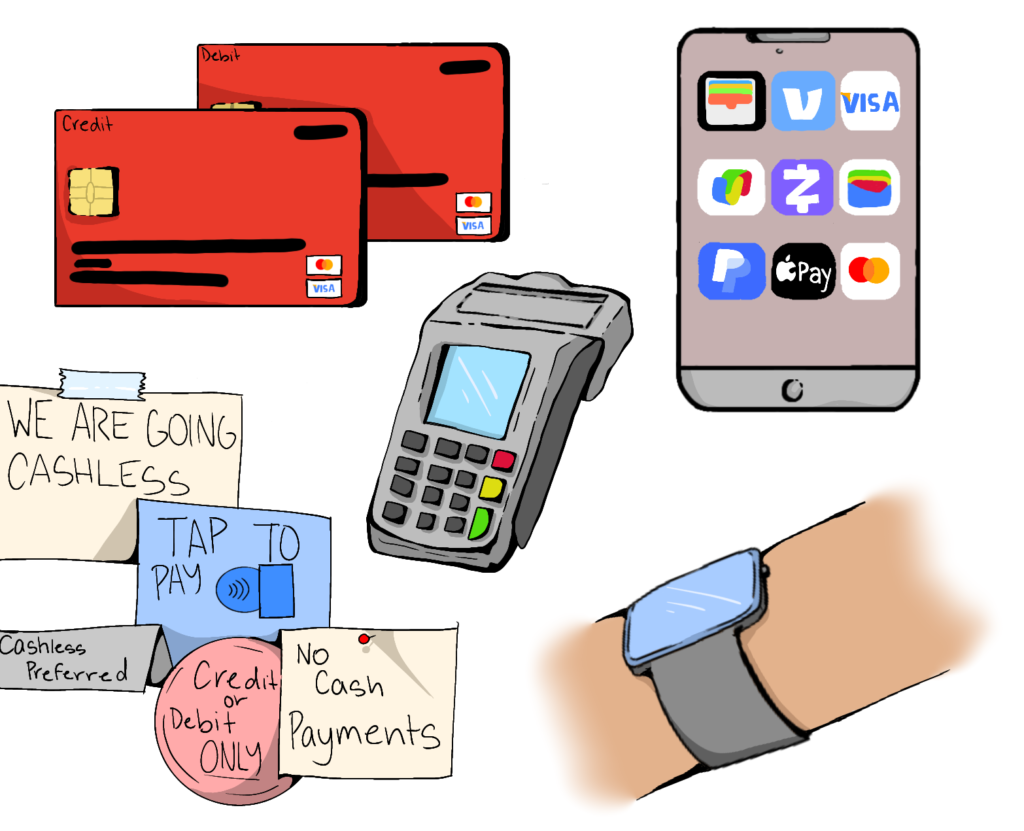
In 1958, the Bank of America launched BankAmericard, the world’s first consumer credit card. Sixty thousand of these cards were introduced across Fresno, California, and barely a decade later, 100 million credit cards had been issued across all of America.
Nowadays, credit and debit cards have mostly replaced the faces of Alexander Hamilton and Andrew Jackson within people’s wallets, and the few paper bills that remain seem to serve only for emergencies.
“Cash is just too much to hold on to … A card is way easier to keep track of and pay with”
“Cash is just too much to hold on to,” said sophomore Josh Jacobs. “A card is way easier to keep track of and pay with.”
Some have transitioned entirely out of the physical methods of payment, relying on Apple Pay or Google Pay as their sole method of payment.
Especially since the rise of COVID-19, the benefits of contactless payment have been placed on an unprecedented pedestal. With cash serving as a prime location for bacteria and germs, people were encouraged to use electronic payment and contactless cards as an additional safety precaution.
“In stores, I don’t think I’ve ever seen [a preference toward cashless payments] outwardly, but [cashiers] definitely like to show me the card machine first,” said junior Ashley Roselynn Vincent. “Even with that, I feel like [cashiers] all prefer [customers] to tap now, rather than insert or swipe.”
Even though electronic payments and cards are convenient to carry and favorable in the current social distancing era, there are still a few disadvantages to these transaction methods.
“I still like paying with cash,” said freshman Alisson Escobedo. “I feel safe [and] … secure. And I know how much money I’m paying. Sometimes there’s also a fee when you pay with a card.”
Annual fees, interest charges and late payments are all factors to consider when applying for a credit card. Although keeping up with these fees can boost one’s credit scores, irresponsibility and overspending can wreck them just as easily. According to a study by Credit Karma in which the company analyzed the bank accounts of 73 million Americans, the average credit card debt per person in 2022 was $6,298.
In addition to these fees, the loss of a visual reminder of how much one is spending seems to be a disadvantage with cashless payments.
“It’s so easy to spend money [on cashless purchases]”
“It’s so easy to spend money [on cashless purchases],” Vincent said. “There’s less thought that goes into [spending] and I find myself spending more money in places where I wouldn’t usually. Of course it’s convenient, but I think in that sense, it’s almost too easy.”
Furthermore, electronic payments were not considered mainstream until early 2019. Although most companies have implemented these transaction methods, there still remain many locally-owned stores and small businesses that may not have electronic payment options.
“[The store I work at] just recently allowed Apple Pay,” said senior Shreya Arjun. “Before that we only allowed credit cards and cash. It was really uncomfortable because I [had to tell customers], ‘I’m sorry, we don’t take Apple Pay.’ And we’ve lost a few customers that way.”
However, the preference for electronic and card payments still exceeds cash, as is apparent in the numbers. According to the Federal Reserve Bank of San Francisco, most in-person payment were made using debit and credit, with debit cards accounting for 44% of these payments and credit cards taking another 32%. In total, 76% of all in-person payments in 2021 were made with a card, compared to 19% made using cash.
With the majority of America’s population using cashless payments, as well as the exponential increase of these payment methods over the past few years, a society without cash may perhaps be the future.



